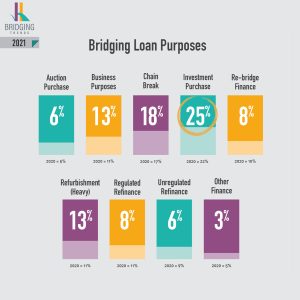bridging lending surges in 2021
The UK bridging market showed signs of a positive and steady recovery in 2021, according to the latest Bridging Trends figures.
In total, £626.7 million in bridging loans were transacted by those who contribute to the data, up from £455 million in 2020- an annual increase of 38%.
Quarters 1, 2 and 4 all saw consistent levels of lending from contributors (£144.5m, £146.5m and £145.4m respectively) with volume peaking in Q3 to £190.24m. This surge was driven by the strong housing market activity as buyers raced to take advantage of the stamp holiday before the deadline of 30th September.
Bridging Trends combines bridging loan completions from several specialist finance packagers operating within the UK bridging market: Adapt Finance, Brightstar Financial, Capital B, Clever Lending, Complete FS, Enness Golab, Finata, Impact Specialist Finance, LDNfinance, Optimum Commercial, Sirius Group and UK Property Finance.
Bridging Loan Purposes
Funding an investment purchase was the most popular reason for taking out a bridging loan in 2021 and accounted for 25% of all contributor completions. This was up from 22% in 2020. The second most popular use for bridging finance in 2021 was to fund a chain-break, which made up 18% of all transactions. These figures highlight how bridging finance continues to be an attractive proposition to buyers who are facing tight deadlines or are looking to save their delayed property purchases.
Average LTV
The average LTV increased from 50.7% in 2020 to 56.9% in 2021, highlighting how borrowers maximized liquidity opportunities and took advantage of rates in light of reports that mortgage rates in general were heading upwards imminently.
‘Maximum loan to value’ was also the top criteria search made by bridging finance brokers in 2021, as reported by Knowledge Bank. This further indicates a growing demand for higher LTV products.
‘Regulated bridging’ was the second most-searched for term with ‘minimum loan amount’ in third.
Transaction Breakdown
The amount of second charge bridging loans plunged from 23% in 2020 to 15% in 2021, the lowest annual figure Bridging Trends has ever reported. Elsewhere, regulated bridging loans accounted for 40.8% of all contributor transactions in 2021, down from 49% in 2020. The demand for regulated bridging was at its highest during the first half of the year as homeowners rushed to complete before the end of the first stamp duty holiday deadline on 30th June.

Average Monthly Interest Rate
Encouragingly for borrowers, the average monthly interest rate fell to 0.76% in 2021, compared to 0.79% in 2020. This is attributed to increased competition between bridging finance lenders, who are in turn providing more options for borrowers- a trend we see continuing throughout this year, too.
Average Term & Time
The average term of a bridging loan in 2021 stayed static at 12 months while the average processing time increased slightly, from 50 days in 2020 to 52 in 2021.
Despite the challenges faced over the last 12 month, the bridging finance industry is certainly moving in a positive direction. As 2022 progresses, we expect figures to fully recover and surpass 2019 gross lending as more investors return to the market with a view to taking early advantage of the anticipated impact inflationary pressures will have on asset prices. Because of this, we are also expecting to see ‘investment purchase’ as the largest demand driver for bridging finance in 2022.
If you’d like to find out how a bridging loan could be the faster solution to your funding requirements, please don’t hesitate to contact us.





